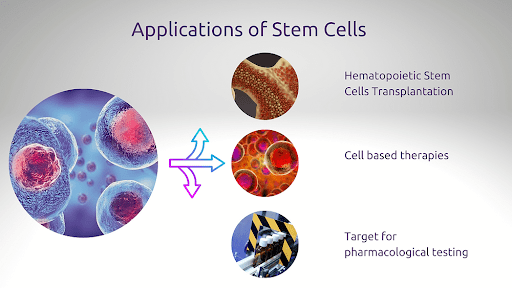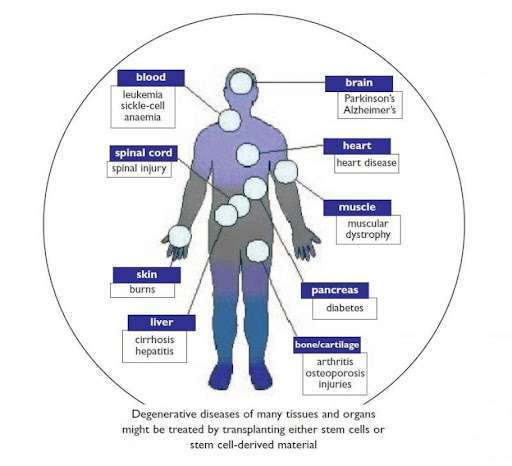How do stem cells impact the future of medicine?
How could stem cells be used in the future?
How have stem cells changed the world?
How are stem cells already used in medicine?
Sources of stem cells
Diseases treated with stem cells
Arthritis
Cancer
Parkinson’s disease
Autism spectrum disorder
Heart diseases
Diabetes
Fibromyalgia
Kidney diseases
Conclusion
Stem cells are the most unique cells in the body with the ability to generate new cell types. Their remarkable potential to renew themselves into different cell types during early life and growth has revolutionized medicine. In this article, we will take a look at the uses of stem cells in medicine and what promising scope they have in curing fatal diseases.
Table of Contents
How do stem cells impact the future of medicine?
Stem cells are undifferentiated, early predecessor cells that have the ability to self-renew indefinitely. Under exceptional circumstances and appropriate signals, they can differentiate into mature specialized cells of any kind.
Here are a few ways stem cells have helped medicine:
- Basic knowledge about the development of diseases.
- Drug discovery.
- Inventing cell-based therapies.
Stem cells have transformed medicine and are being widely used today by scientists to understand diseases and find promising drugs or therapies to treat diseases like diabetes, Parkinson’s disease, autism treatment with stem cells, spinal cord injury, heart disease, vision and hearing loss.
How could stem cells be used in the future?
Stem cells are remarkable but with a very complex nature, which requires a lot of research into their properties and effects. Decades of study have enabled scientists to understand their potential to treat diseases.

In the future, we might witness stem cell therapy as a common option for treating eye diseases like macular degeneration, multiple sclerosis, etc. clinical trials are being conducted for many health conditions. For example, Japanese scientists have already conducted a clinical trial for treating Parkinson’s disease using reprogrammed stem cells (iPSCs). It has shown positive results where adult stem cells are injected into the brain with the hope of restoring normal function.
Moreover, stem cell techniques are already being trialed to repair areas of the heart damaged in a heart attack without leaving any scar tissue. This technique is still at an early stage, but if mastered, it could support other body organs like the heart, lung, liver, pancreas – and perhaps nervous system tissues. The future of stem cells in medicine will certainly be enlightening.
How have stem cells changed the world?
Unlike muscle cells, blood cells, or nerve cells, which are incapable of replicating themselves, stem cells have the ability to replicate many times, as well as promote regenerative processes in the tissues.
When a stem cell divides, it replicates itself into two cells that can be either:
- Both stem cells.
- A stem cell and a more differentiated cell.
- Both differentiated cells.
Given this unique quality, stem cells have been widely used in biomedical research and therapeutic development. Stem cells in medicine have changed the world by:
- Helping scientists learn about human biology for the development of therapies.
- A better understanding of the genetic and molecular signals that regulate cell division.
- Stem cell differentiation that yields information about how a disease surfaced and also helped suggest possible therapies.
- IPSCs that are made from a patient’s stem cells and can be differentiated into “organoids” (small models of organs) for studying diseased cells and testing drugs.
- Using stem cells to generate cells and tissues for cell-based therapies or tissue engineering.
How are stem cells already used in medicine?
Stem cells have no specific functions within the body but have the natural power of turning into any required cell. They have the capacity to generate specialized cells like blood cells, brain cells, heart muscle cells, and bone cells.
Apart from their ability to mature into specialized cells, stem cells can also repair damaged and diseased organs through paracrine mechanisms. They are also known to have anti-inflammatory and antioxidant effects. All these make them the apt option for several medical issues.
Sources of stem cells
To understand stem cell practice in medicine, it’s crucial to know its source. The two main sources of stem cells are:
1. Adult body tissues. Stem cells are also present inside different types of tissue, that include bone marrow, cord blood, skin, placenta, and fat tissue. These types of cells are mostly used in stem cell therapy.
2. Embryos. These cells are mainly used in research rather than human therapies due to an ethical issue.
Diseases treated with stem cells

Stem cell therapy is very effective in treating painful long-term conditions or coming with certain symptoms. Though cell therapy is self-sufficient, combining it with other treatments can have optimal effects. Here are eight conditions that are being treated with stem cells.
Arthritis
Stem cell therapy helps repair damaged joint cartilage and reduce inflammation in and around the joint.
Cancer
Stem cells help treat conditions like leukemia and lymphoma by replacing damaged cells.
Parkinson’s disease
The therapy can also help repair nerve damage by replacing the dopamine-inducing brain cells that are destroyed in Parkinson’s.
Autism spectrum disorder
Stem cells in regenerative medicine have been found to be a promising treatment for ASD individuals. Stem cells reduce neuroinflammation and improves metabolism in hypometabolic areas in the brain. Combining stem cell therapy with other behavioral therapies for lasting effects is often effective. To have a better insight into what to expect from stem cell therapy for autism, you can contact the stem cell therapy center to get a free online consultation.
Heart diseases
Cardiac regeneration is also something that is achieved by stem cell therapy, where stem cells repair or replace the damaged tissues on the heart or blood vessels, and also help reduce blood pressure.
Diabetes
The therapy effectively replaces missing or damaged beta cells (that produce insulin in the pancreas) and is very effective in treating both type 1 and type 2 diabetes.
Fibromyalgia
Stem cells help modulate inflammatory responses and inflammation related to fibromyalgia. They also help repair and regenerate damaged nerve cells.
Kidney diseases
Since stem cells can protect the kidneys from damage and accelerate healing in kidney diseases.
Conclusion
Stem cells, unlike other cells, have the ability to transform into any other tissue, which makes these cells indispensable in treating chronic medical conditions. Besides treating plenty of diseases, Stem cells have also helped scientists understand more about diseases and their origin immensely. With more advancements in regenerative medicine, we will soon be able to observe the full potential of stem cells in saving lives and transforming medicine.


